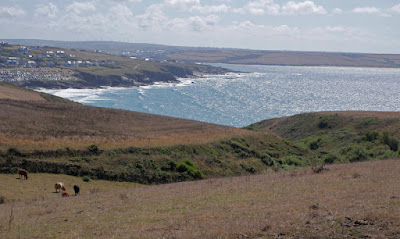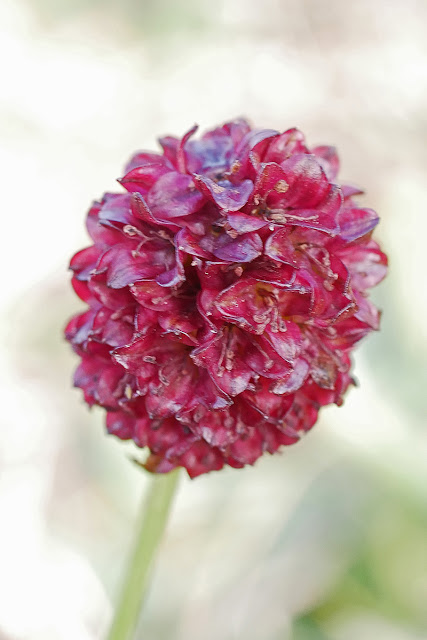Not a sign of rain yet, but the plants keep on coming. Here is a summary of the more interesting or rare finds I made from mid Cornwall at this time.
To start off, I took a walk down a small stream that ended with an earth barrier to keep the sea out. The fields adjacent to it were heavily grazed by dairy cows, so not much to see there. However, the river banks were fenced off from the cows, so had plenty of interest there. The first plant was one I'd not seen before, but on researching it when I got home turned out to be Wild Celery. As I hate the taste of Celery I didn't try it, furthermore, never taste any part of umbellifer type plants unless you really are sure what it is. Some, such as Hemlock Water-Dropwort are fatally poisonous!
Apium graveolens
On the moors, the dominant Forget-me-not is Tufted, which is a very pale blue with mid sized flowers. So when I came across this Water Forget-me-not I was struck by its much larger and deeper blue flowers. As with all Forget-me-nots, check out the hairs on the stem and calyx to properly determine their identity.
Myosotis scorpioides
Another plant that likes its feet wet is the Celery-leaved Buttercup. It has quite small and dainty flowers and can be quite a large plant with many branches tipped with these flowers.
Ranunculus sceleratus
It's not just about flowers. Here's a nice example of a Branched Bur-Reed with its characteristic spikelets.
Sparganium erectum ssp neglectum
As I crossed over the earth barrier to the estuary, the flora completely changed with the saline influence. In one place was a dense stand of Sea-Club-Rush.
Bolboschoenus maritimus
On the mud were lots of Lesser Sea-Spurries and in one place a clump of Greater Sea Spurry. These are not as common here as Rock Sea Spurry, unsurprisingly given that cliffs and rocks outnumber estuaries by a large number.
Spergularia marina
Sea Arrow Grass was common, but all but this one were in seed, not that the flowers are particularly impressive anyway!
Triglochin maritima
Both varieties of Sea Aster were present. One has purple ray petals (var. tripolium) and the other lacks it as below.
Tripolium pannonicum var flosculosus
From estuaries to exposed sea cliffs which is home to Sea Spleenwort that hides away in cracks and fissures in the rocks.
Asplenium marinum
On the sheltered side of the cliffs were some fields managed by the National Trust. Within this very dry and arid field were two stands of Field Eryngo, a rare plant indeed. There were still some of its small white flowers present, though most were now in seed. In Kent, there are two sites for it and it's called the Watling Street Thistle.
One field had some Chickory growing along its edges.
Cichorium intybus
Common Restharrow in the same field. It's not often one sees the flowers completely open as here.
Ononis repens
A Meadow Grasshopper from these fields.
Chorthippus parallelus
A few miles inland and it is completely different scenery on Bodmin Moor. Here is a view of a tiny part of Colliford Lake on the Moor with Heather and Western Gorse flowering in the foreground.
If you see extra large flowers on what initially looks like Tormentil, look again. On examining the leaves and seeds of this pant, it was obviously Trailing Tormentil. This is hard to identify until it has plenty of flowers with some seeding. The similar looking hybrid P. x mixta is almost sterile, so seeds present rule that out. Both will likely have 4 and 5 merrous flowers too.
Potentilla anglica
A few miles away, but still on the moor, was a riverside location popular with picnickers and families. Amongst the people enjoying the sun and cooling off in the river were some special plants.
Tiny harebell like flowers showed the presence of Ivy-Leaved Bellflowers.
Wahlenbergia hederacea
Some Cross-leaved Heath looking lovely on the moor.
Erica tetralix
Miniature Corn Mint in flower on the banks of Colliford Reservoir. Heavily grazed, they have to flower small or be noticed too soon and eaten. These were less than 2" tall.
Mentha arvensis
I have saved the best plant until last. Close to the splashing children in the river were patches of Coral Necklace, a very rare plant. On the opposite side of the river was the largest colony, several metres long along the river bank. The 20p coin shows its size nicely.
Illecebrum verticillatum
August ended with trips to various habitats including an estuary, freshwater stream, exposed sea cliffs, arable fields and the largest moor in Cornwall. By varying your trips you visit more diverse habitats and see more species. The scenery is usually wonderful too.
Until next time, take care.
Dave




























































